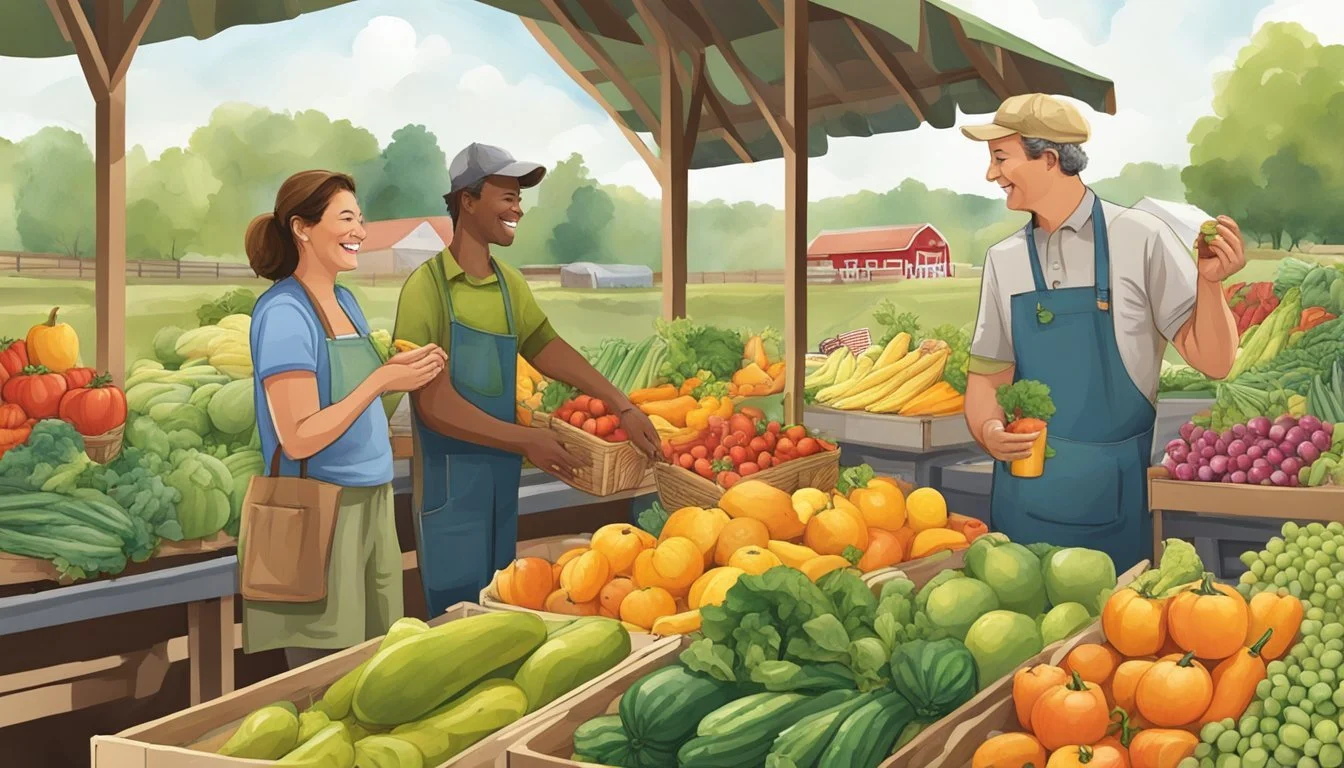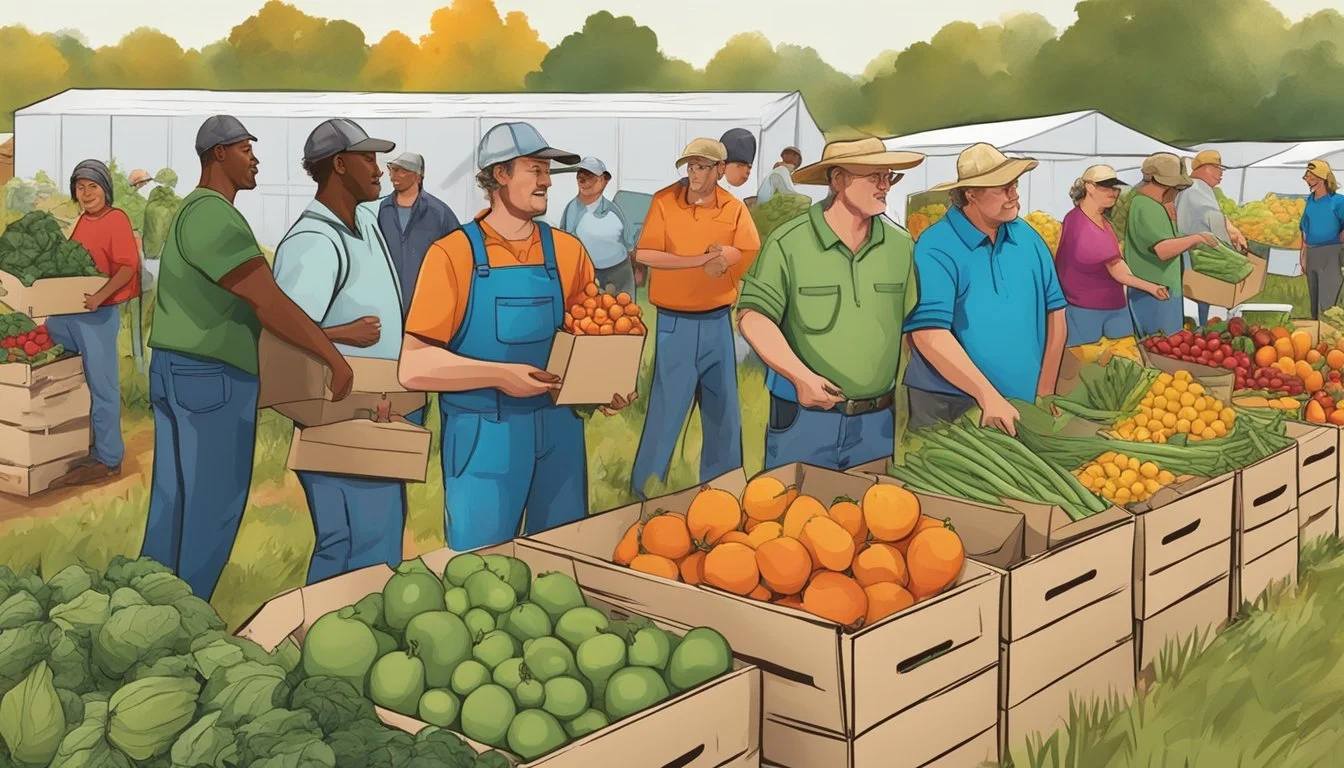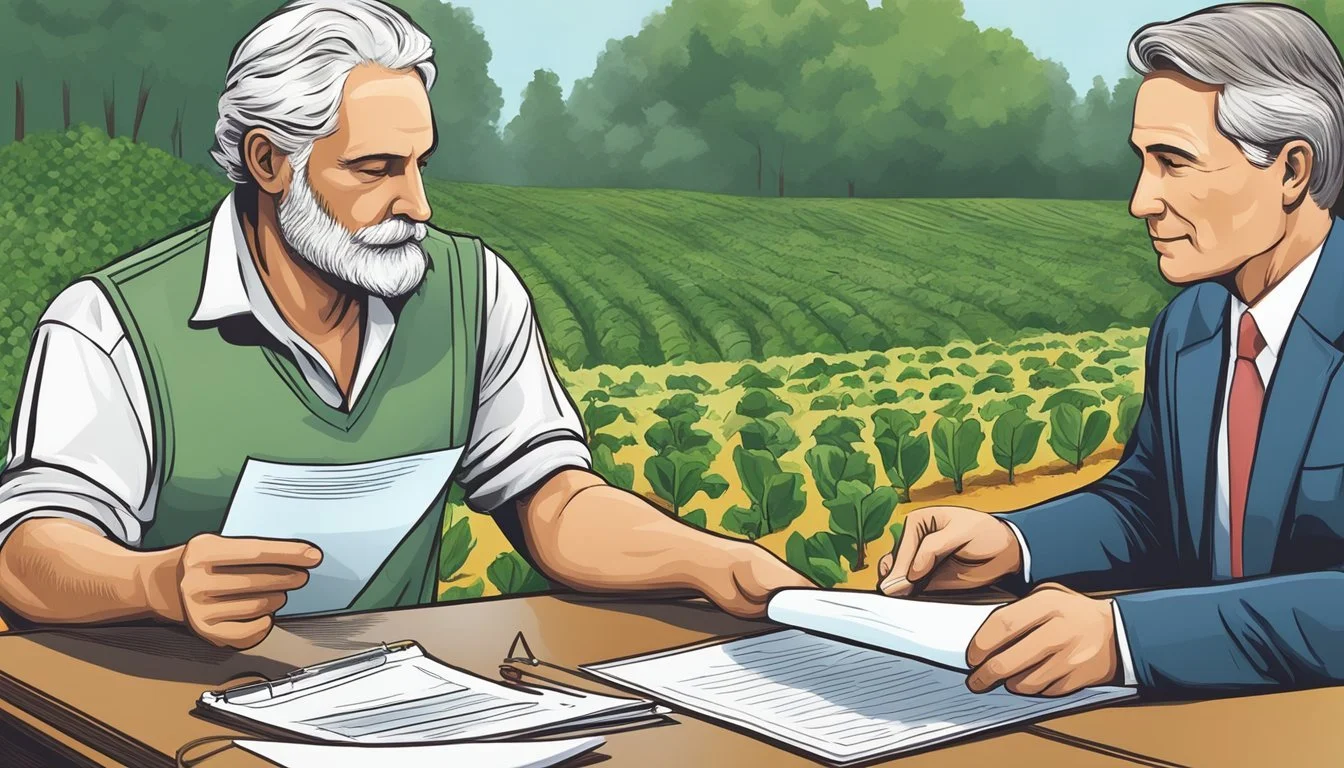Community Supported Agriculture (CSA) in Maryland
A Guide to Local Produce Partnerships
Community Supported Agriculture (CSA) provides a direct connection between consumers and local farmers in Maryland, fostering a partnership where individuals receive fresh produce while supporting local agriculture. In Maryland, CSA programs are increasingly popular due to their role in allowing residents to partake in a sustainable food system. Subscribers pre-pay for a share of the harvest, which not only ensures a distribution of fresh, seasonally available fruits and vegetables but also helps stabilize farm income and reduces marketing costs.
The variety of CSA programs in Maryland caters to a range of preferences, offering everything from vegetables, fruits, and herbs to meats and other farm products. This diversity reflects the state's rich agricultural heritage and its adaptability to modern consumer demands. Maryland's CSA members have the unique opportunity to experience new produce and develop a deeper appreciation for seasonally grown food, significantly different from what one would typically find on grocery store shelves.
Local farmers are at the core of CSA programs in Maryland and are responsible for delivering quality and variety to their subscribers. By committing to supply a consistent quantity of farm products throughout the season, these farmers can maintain a loyal consumer base, crucial to their business's sustainability. Maryland's CSAs thus represent a multifaceted initiative where local economies, community well-being, and environmental stewardship are all cultivated through this symbiotic relationship.
Understanding CSA
Community Supported Agriculture (CSA) in Maryland exemplifies a sustainable partnership between consumers and farmers. It is underpinned by a subscription-based model that emphasizes mutual benefits.
Concept and History
Community Supported Agriculture began as a way for consumers to invest directly in local farms with upfront subscriptions. In Maryland, the practice has seen notable growth, mirroring national trends. This early investment helps farms cover initial production costs. Historically, CSA took root in the 1980s in the United States, but it stems from European and Japanese influences.
Benefits for Consumers and Farmers
Consumers benefit from CSAs by receiving fresh, locally-grown produce, which often exceeds the quality found in traditional retail outlets. They also enjoy a closer relationship with the source of their food, fostering transparency and trust.
Farmers, on the other hand, gain a reliable income stream and reduce marketing costs. This direct-to-consumer model also ensures they receive better prices for their crops, as there are fewer middlemen involved. The upfront capital from subscriptions allows for better financial planning and may reduce the reliance on loans.
CSA Models and Structures
There are various CSA models and structures which can vary from farm to farm. A common structure includes:
Standard Share: A fixed assortment of produce distributed weekly
Market-Style: Members select their own products up to a certain value
PYO (Pick-Your-Own): Members help harvest their share
Each of these models operates on the fundamental CSA premise: consumers pay in advance for a season's worth of agricultural products. This model benefits agricultural operations by ensuring a stable customer base and providing farmers with working capital at the start of the season.
CSA in Maryland
Community-supported agriculture (CSA) has become a crucial part of Maryland's sustainable farming and local food movement, creating a direct link between farmers and consumers.
Local Impact
CSAs in Maryland significantly benefit local farmers and rural communities. Consumers pre-purchase shares of the harvest, providing farmers with necessary early-season capital. This system also fosters local economic growth as it keeps spending within the community. Moon Valley Farm in Woodsboro is a notable example, offering certified organic vegetables and herbs through their year-round CSA program, also contributing to school programs and local gardeners with their seedlings.
Maryland Department of Agriculture
The Maryland Department of Agriculture actively supports CSAs and encourages state residents to participate in them. Through initiatives and promotional weeks, such as CSA Week, the department highlights the importance of these programs. Their efforts ensure farmers receive advanced support for their seasonal production, which helps stabilize farm income and reduce marketing costs.
Maryland’s Best Program
The "Maryland's Best" program functions as a marketing tool, connecting consumers to local agricultural products and CSAs. The program assists Maryland farmers by promoting their CSA programs, which often include a diverse range of locally grown fruits, vegetables, and additional farm products. This initiative is key to expanding the reach of CSAs to more households across the state, contributing to agriculture being one of the state’s top industries.
Farmers benefit from CSAs as they provide a degree of financial security and enable them to plan their crop sizes appropriately, reducing the risks of overproduction. Additionally, consumers get the chance to try new varieties of produce and develop a deeper connection with their food source. CSA programs are an embodiment of Maryland’s commitment to preserving its agricultural roots while innovating for a sustainable, food-secure future.
Joining a CSA
Joining a Community Supported Agriculture (CSA) program in Maryland is a straightforward process that involves selecting a local farm, understanding the membership terms, and knowing what to expect from the shares distributed throughout the season.
How to Find a CSA
To find a CSA in Maryland, potential members can:
Visit local farmers' markets: Engage with local farmers directly to learn about available CSA programs.
Search online: Utilize websites and online databases dedicated to CSAs and local food networks.
Check local listings: Often, community boards, agricultural extensions, and social media groups offer information on CSA programs.
When considering a CSA, it is important to review:
The variety of produce offered, including vegetables, fruit, herbs, and more.
The pick-up location and whether it aligns with your routine.
Any included meats, eggs, or other products that enhance the share's value.
Understanding Membership
CSA membership involves:
An upfront subscription fee, paid in advance to support the farm's production costs.
Entering into a CSA membership agreement, which outlines terms like duration, quantity, and type of products offered.
Before joining, ensure that the CSA's offerings align with your family's needs and preferences. Remember that by becoming a member, you're directly supporting a local farmer and contributing to the sustainability of agriculture in your community.
What to Expect in a Share
Typical CSA shares include:
Fresh, in-season produce: Members can expect a rotating selection of fruits, vegetables, and herbs throughout the growing season.
Farm-fresh extras (if available): Depending on the farm, shares may also include meats, eggs, and specialty products.
Share sizes: Many CSAs offer different share sizes to cater to individual or family needs.
Be prepared to receive a variety of items and sometimes new produce you may not be familiar with. Part of the joy of CSA membership is the opportunity to explore new foods and cooking methods while enjoying fresh, locally grown fare.
Benefits of Participating in a CSA
Participating in Community Supported Agriculture (CSA) in Maryland offers tangible perks, notably in the freshness and quality of produce, bolstering the local economy, and contributing to environmental sustainability.
Freshness and Quality of Produce
CSAs in Maryland excel in delivering farm products that are often harvested within 24 hours of pick-up or delivery, ensuring peak freshness and taste. Members savor the seasonal food that reflects Maryland's rich agricultural calendar, from summer's succulent tomatoes to fall's crisp apples. This model contrasts sharply with supermarket counterparts, where produce travels long distances and may lose nutritional value.
Supporting Local Economy
Opting for a CSA stimulates Maryland's local food systems by channeling funds directly into area farms. This model helps preserve farming livelihoods and invests in local communities. By contributing to local food security, CSA members nurture a resilient supply chain where food dollars stay within the community, supporting neighboring farm operations and sometimes even local artisans and businesses through variety of products included in CSA shares.
Environmental Benefits
CSA models endorse environmental stewardship. Shorter transportation distances for fresh local produce reduce carbon footprints. Moreover, many CSA farms in Maryland practice sustainable farming methods that minimize the use of harmful pesticides and fertilizers, protect water resources, and promote soil health. Participants share in the responsibility of fostering an ecosystem-friendly approach to agriculture.
Challenges and Considerations
Engaging in Community Supported Agriculture (CSA) in Maryland involves thoughtfulness from both consumers and farmers. Challenges extend from managing expectations to the inherent risks and seasonal variability associated with agriculture.
Managing Expectations
Farmers must clearly communicate what consumers can expect concerning the variety, quantity, and quality of the season’s harvest. Consumers anticipate a degree of transparency about the type and amount of produce they will receive weekly.
Understanding the Risks
Both parties share the agricultural risks. While farmers bear the frontline uncertainties, such as crop failures, consumers must also be prepared for fluctuations in their expected harvest. Consistent and clear contracts help in delineating these risks.
Seasonal Variability
Seasonal variability affects the harvest outcome, making it vital for both farmers and consumers to have realistic plans. These plans should address potential changes in crop variety, sizes, and harvest times due to the unpredictable weather patterns in Maryland.
Marketing and Promotion
In Maryland, Community Supported Agriculture (CSA) farms are adopting targeted marketing strategies and leveraging digital platforms to enhance their visibility and connect with their community.
Marketing Strategies for CSA Farms
CSA farms in Maryland have recognized the importance of employing diverse marketing tactics to differentiate their offerings. Such strategies often include setting up at central locations like local farmers' markets to capture the attention of potential members. Discounted rates for early sign-ups or special rates for long-term memberships are used to encourage commitment, ensuring financial stability for the farm.
Utilizing Social Media and the Internet
The power of social media and the internet cannot be overstated for CSA farms. Platforms like Twitter provide an opportunity for direct interaction with members and potential customers. These online tools are used to share updates, harvest schedules, and engaging content that tells the story of the farm and its practices. A well-maintained website serves as the hub for information, sign-ups, and member management.
Partnerships and Collaborations
Partnerships and collaborations have proven to be successful in promoting CSA memberships. Aligning with local businesses, for example, allows CSA farms to establish drop-off points, which provides convenience for members and visibility in high-traffic areas. Collaborative events with other local farmers or businesses boost CSA awareness and cement the farm's position within the local economy.
Legal and Financial Aspects
Community Supported Agriculture (CSA) in Maryland operates on a foundation of shared commitment and risk, with legal and financial intricacies that include transparent subscription agreements, well-managed liability measures, and strategic financial planning.
Subscription Agreements and Fees
Subscription agreements are vital in a CSA as they outline the terms and expectations between the farmer and the community members. In Maryland, members typically pay a subscription fee up front, which amounts to a pledge to support the farm’s anticipated production costs for a season. This fee structure facilitates predictable income and financial stability for the farmer, while providing members with a share of the crops. An agreement may also include a clause for donation as a form of support to the farm or it may serve as a convenient option for members who wish to donate their share.
Insurance and Liability
Farmers must navigate legal concerns, such as liability for on-farm events. They often mitigate risk through insurance policies, which can cover both the property and potential injuries to members participating in CSA activities, like berry picking. A solid insurance strategy is key to safeguarding the business against unforeseen events, potentially including the risks of crop failure.
Financial Planning for CSA Operations
Strategic financial planning is essential to ensure the sustainability of a CSA. This involves setting appropriate pricing for shares, which must cover production costs and account for profits. It benefits the operations to have a financial buffer, maintained through a combination of member fees and potentially other financial venues, such as grants or loans. Careful budgeting and financial management help foresee and cover expenses throughout the growing season, ensuring that the CSA remains viable.
Financial considerations are not taken lightly in Maryland CSAs, and they are often reviewed by agricultural experts including the Agriculture Secretary Joe Bartenfelder. Affordability and convenience for members are balanced with the need for the farm to maintain financial health and cover operational costs.
Community and Outreach
Community Supported Agriculture (CSA) in Maryland strengthens connections between Marylanders and local farmers, facilitating education, communal engagement, and mutual support.
Education and Engagement
Maryland's CSAs provide valuable opportunities for consumer education about sustainable agriculture practices. Participating farms often engage community members through detailed newsletters and host periodic farm visits where individuals can learn directly from the farmers about the cultivation processes. This enhances transparency and fosters trust in the farm-to-table journey.
Community Events and Pick-up Sites
Throughout Maryland, CSA programs routinely organize community events that serve as both pick-up locations for shares and hubs for local interaction. Farmers markets in the county often double as convenient CSA pick-up points, promoting direct dialogue between consumers and the agricultural community. These sites become crucial touchpoints for exchanging ideas, answers to questions, and receiving fresh, locally-grown produce.
Donations and Community Support
To bolster community support, many CSA farms in Maryland partner with local food banks and charities, facilitating donations of fresh produce to those in need. This not only addresses food security but also reinforces the communal spirit inherent in CSA models. The USDA National Agricultural Statistics Service evidences the reciprocal benefits of such initiatives, as they contribute to a healthier, more food-secure county.
Resources
In Maryland, a wealth of resources is available for those interested in participating in Community Supported Agriculture (CSA) programs. These resources range from CSA farm listings to valuable agricultural contacts and information for both consumers and farmers.
CSA Farm Listings
Maryland offers a diverse array of CSA farm options for consumers seeking fresh, locally sourced products. These listings are centralized on platforms such as Maryland's Best, which is an excellent place to start:
Website: Maryland's Best
Featured CSA Farms:
5 A DAY CSA
Location: Silver Spring, MD
Phone: 301-595-0379
Website: 5adaycsa.com
Backbone Food Farm
Location: Oakland, MD
Phone: 301-334-5633
Website: backbonefarm.com
These listings provide consumers with direct access to an array of locally grown and locally produced goods, ensuring support for local farms and sustainable agriculture practices.
Agricultural Resources and Contacts
For those looking to delve deeper into agricultural endeavors, Maryland provides comprehensive contact information for extension services, organic farming associations, and local CSA networks:
Maryland Organic Food & Farming Association (MOFFA):
Website: Maryland Organic
University of Maryland Extension:
Website: UMD Extension
Montgomery County Maryland CSA:
Various Locations in Montgomery County
Website: Montgomery County CSA
These organizations offer guidance and support to both farmers and consumers interested in organic farming and CSA participation.
Frequently Asked Questions
CSA programs often raise common questions among the public, ranging from how to join a CSA to understanding the benefits and responsibilities of membership. Key questions include understanding seasonal produce availability, pick-up logistics, and payment methods. Most organizations and farms offer a FAQ section on their websites, but for personalized inquiries, it is best to contact the CSA provider directly.
Example Contacts for FAQs:
5 A DAY CSA
Email: info@5adaycsa.com
Backbone Food Farm
Email: info@backbonefarm.com
By utilizing these resources, individuals can make informed decisions about CSA involvement, benefiting from the nourishment of locally harvested food while directly supporting Maryland's farming community.







